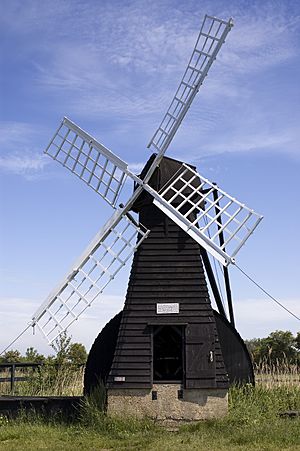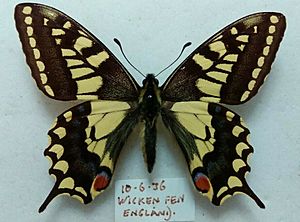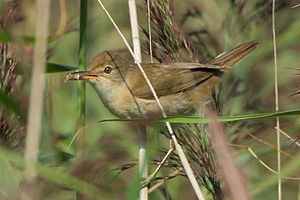Wicken Fen facts for kids
| Site of Special Scientific Interest | |
 |
|
| Area of Search | Cambridgeshire |
|---|---|
| Interest | Biological |
| Area | 254.5 hectares |
| Notification | 1983 |
| Location map | Magic Map |
|
Designations
|
|
| Official name: Wicken Fen | |
| Designated: | 12 September 1995 |
|---|---|
| Reference #: | 752 |
Wicken Fen is a very special nature area in Cambridgeshire, England. It covers about 254.5 hectares, which is like 350 football fields! It's known for its amazing wildlife and plants.
Wicken Fen is protected in many ways. It's a Site of Special Scientific Interest, a National Nature Reserve, and a Ramsar wetland. This means it's important for nature not just in the UK, but around the world.
A big part of Wicken Fen is looked after by the National Trust. It's one of Britain's oldest nature reserves. The National Trust started caring for it way back in 1899. The reserve has different types of land, like fenland, farmland, marsh, and reedbeds. Wicken Fen is one of only a few wild fens left in a huge area called the Great Fen Basin. Most of the other fens have been turned into farms.
Contents
Wicken Fen: A Managed Reserve
How Wicken Fen is Cared For
Even though Wicken Fen feels wild, it's actually carefully managed by people. Humans have been involved with the fen for hundreds of years. Today, the reserve is looked after to protect its delicate balance of plants and animals.
Much of the work done here tries to copy old ways of farming the fen. These methods helped many species grow and depend on these practices. For example, a plant called sedge (Cladium mariscus) is cut every year. This sedge is then sold to thatch roofs. People have been cutting sedge at Wicken since at least 1414! This regular cutting helps many plants and animals that need open areas to survive.
To help keep the fen healthy, Konik ponies and Highland cattle have been brought in. They graze in some areas. This stops too many bushes from growing and helps keep the habitat open for other species.
The Historic Windpump
Wicken Fen has the very last wooden windpump in the Fens. This small pump was likely built around 1912. It was used to drain water from the land. In 1956, the National Trust moved it to its current spot and fixed it up.
Today, the windpump helps keep the water levels high in the fen. It pumps water from a drainage channel back into the fen. Nearby museums, like Stretham Old Engine and Prickwillow Museum, can tell you more. They show how steam engines and then diesel engines replaced windpumps over time.
Science at the Fen
Wicken Fen has a long history with natural science. Charles Darwin himself collected beetles here in the 1820s! Many famous naturalists from the Victorian era also studied insects like beetles, moths, and butterflies at Wicken Fen. Some of their collections are still in museums today.
Many rare species have been found here. One famous example is the swallowtail butterfly. Sadly, it disappeared from the fen in the 1950s, even after people tried to bring it back.
From the 1920s, important scientists like Sir Arthur Tansley and Sir Harry Godwin did their early work here. They were pioneers in the study of ecology and conservation. One of the world's longest-running science experiments, called the Godwin Plots, is still happening at the fen today. Scientists from places like Cambridge University are still very involved. They help manage the reserve and publish many research papers about Wicken Fen.
Visiting Wicken Fen
Wicken Fen is open for everyone to visit. It's open from morning until evening every day, except for Christmas Day. Sometimes, if it's very wet, some paths might be closed. However, there's a special boardwalk that leads to two bird hides. This boardwalk is always open.
You can find several bird hides and many miles of trails to explore. There's also a visitor centre, a shop, and a café. The visitor centre has an exhibition where you can learn about Wicken Fen's history and why it's so important for nature. On Sundays, you can visit Fen Cottage. It shows what life was like for people living in the fens around 1900.
Amazing Wildlife at Wicken Fen
Wicken Fen is famous for its huge variety of plants and animals. People have been recording species here for a long time. Because of this, there are very long lists of all the different living things found at the fen. Even today, new species are still being discovered! In 1998, over 20 new species were found, and in 2005, another 10 were added.
Wicken Fen became a nature reserve because of its incredible invertebrates (animals without backbones) and plants. So far, over 8,500 different species have been recorded here. More than 125 of these are listed in the Red Data Book, which means they are rare or endangered.
Invertebrates: Tiny Creatures, Big Impact
The reserve is home to many kinds of flies, snails, spiders, and beetles. You can spot different types of damselflies, like the emerald, azure, and large red. Dragonflies like the southern and brown hawkers also live here.
The fen is also rich in moths and butterflies. There are over 1000 species of moths, including rare ones like the reed leopard. Local butterflies include the green hairstreak and brimstone. You can also find various freshwater and land snails, including the rare Desmoulin's whorl snail.
Birds: Feathered Friends
While the fen is famous for its insects and plants, many birds can also be seen. Birds are often easier to spot than the smaller creatures, making them popular with visitors.
Birds that live here include the great crested grebe, cormorant, and teal. You might also see sparrowhawks, water rails, and kingfishers. Owls like the barn, little, and tawny owls also make their homes here.
Many other birds visit Wicken Fen at different times of the year. These include the bittern, whooper swan, and marsh harrier. If you visit during the right season, you'll likely hear the unique "drumming" sound of snipe.
Plants: Green Wonders
Wicken Fen has many special plants. These include the fen violet, a very rare flower. You'll also find great fen sedge (Cladium mariscus), which is harvested for thatch. Other notable plants are marsh pea, greater spearwort, and different kinds of marsh orchids.
In the ditches and ponds, you can see various stonewort species. There are also beautiful flowering rush, water millefoil, and yellow and white water lilies.
Images for kids





